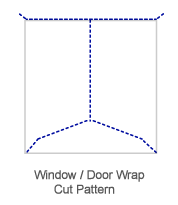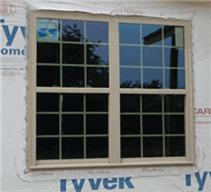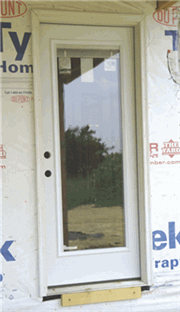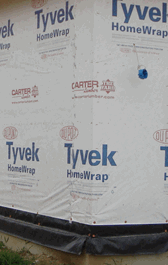How to Install a House Wrap Barrier
A barrier is exactly what home wrap is, acting between the inner and outside
elements. Even if not typically thought of that way. How impermeable is the
wrap could be another topic, however.
It is not complicated to install the wrap, all that are needed are a some basic
instructions and few simple tools like a hammer tacker, a blade to cut with
and a means of support for two persons. Ladders might do, but this could be
scaffolds or working platforms. In addition, there is the rolled material
itself and tape formulated for use with the chosen wrap.
First, you will need to select your wrapping material. Usually this is either
Tyvek, or Typar but there are others such as WeatherTrek. Each with its own strong points
based on particular installs. For example, one make/design might be preferred for under stucco
while another might best be used under lap siding.
Probably the most import concept in installing is the direction the wrap is applied.
Start from the bottom and progress up to the top. Which means that each successive layer should
overlap the one below at the edge. This is crucial and not to be overlooked if the layer
is to be effective in holding out the water.
The questionable areas for installers are usually to be found around the window openings,
corners and the doors. The house wrap goes right atop the sheathing and should be attached
before any windows or doors are placed in their openings.
Windows

When approaching a framed window opening, cover the hole with the layer in a continuous fashion right
over the window void as you normally would the wall (less fastening of course).
And return to cut the opening.
The way in which the wrap is cut helps determine if the
water will pass through, to a large degree. While it is up to the applier and
how they are adept at cutting, there is not a 'single way' to form the openings.
Some simply exact an 'I' cut. The image illustrates the top diagonal flanges that enable for the
upper window tab to be slipped underneath. At the lower end, line direction allows for inward folding
at right angles, and these should receive tape like other seams.

Too, a bead of caulk could be run at the head and at the sill behind the wrap. However this will probably have limited success
in sealing against water.
Although rarely done nowadays its seems, there should really be a flashing strip mounted at the head
to divert the downward path of water (the wrap lapped overtop). Today, it is more common to lay on tape,
however much protection this may afford. The photo taken shows the window placed after wrap was installed,
the tab tucked under above, and taped at the side tabs which are adhered, atop the lower flexwrap.
Doors

As with the window, apply the wrap continuously over the door opening before the unit is set and utilizing
the same or similar pattern for cutout. Making a flap at the top where the diagonals have been cut will enable
flashing to be placed behind the layer of wrap.
The door is hung level, normally with the brick mould already factory pre-attached on the outside portion.
Caulk the perimeter with a recommended compound, preferably with the flashing added at the top head mould.
More and more there is an growing trend to bypass this step, of adding the head flashing, even on wooden brick mould,
but doing so will give added protection from infiltration and help prolong the casing, siding material, sheathing and
possibly framing depending on the severity of exposure.
Though not usually the best way, many installers nail the flash right over the wrap.
Corners Inner and Outer

Double up on any corners having higher exposure to the elements. Some installers use felt under the wrap
and some do overwrapping by the same type again. Be aware of layer compatibility between whichever route you decide on taking.
Viewing the image at the right, on closer inspection it can be revealed that there is little more than minimal
overlap at the corner, perhaps 9" or 10" of extension. The installer here merely aligned the logos and print to
make the illusion of a continuous layer. But at least the vertical seam had been taped!
The corner is positioned on a high exposure side.
Taping Seams
All seams should be taped to form an airtight seal on the membrane wherever the layer runs discontinuous.
Minor tears and breaches are also taped. Bigger holes that expose the inner sheathing on installation should
be patched with another piece, by; first cutting a clean square
or rectangular shaped opening,
with again the 45 degree cuts at the top but now to slip in a patch piece beneath, toward the effect of
maintaining overlap at the top - and with the new patch fully on the outside from the top on down to shed water.
Then taping the seams.
Larger exposures yet might have entire sections of wrap replaced.
Be sure to consult with the makers recommended instructions.

 When approaching a framed window opening, cover the hole with the layer in a continuous fashion right
over the window void as you normally would the wall (less fastening of course).
And return to cut the opening.
When approaching a framed window opening, cover the hole with the layer in a continuous fashion right
over the window void as you normally would the wall (less fastening of course).
And return to cut the opening.
 Too, a bead of caulk could be run at the head and at the sill behind the wrap. However this will probably have limited success
in sealing against water.
Too, a bead of caulk could be run at the head and at the sill behind the wrap. However this will probably have limited success
in sealing against water.
 As with the window, apply the wrap continuously over the door opening before the unit is set and utilizing
the same or similar pattern for cutout. Making a flap at the top where the diagonals have been cut will enable
flashing to be placed behind the layer of wrap.
As with the window, apply the wrap continuously over the door opening before the unit is set and utilizing
the same or similar pattern for cutout. Making a flap at the top where the diagonals have been cut will enable
flashing to be placed behind the layer of wrap.
 Double up on any corners having higher exposure to the elements. Some installers use felt under the wrap
and some do overwrapping by the same type again. Be aware of layer compatibility between whichever route you decide on taking.
Double up on any corners having higher exposure to the elements. Some installers use felt under the wrap
and some do overwrapping by the same type again. Be aware of layer compatibility between whichever route you decide on taking.